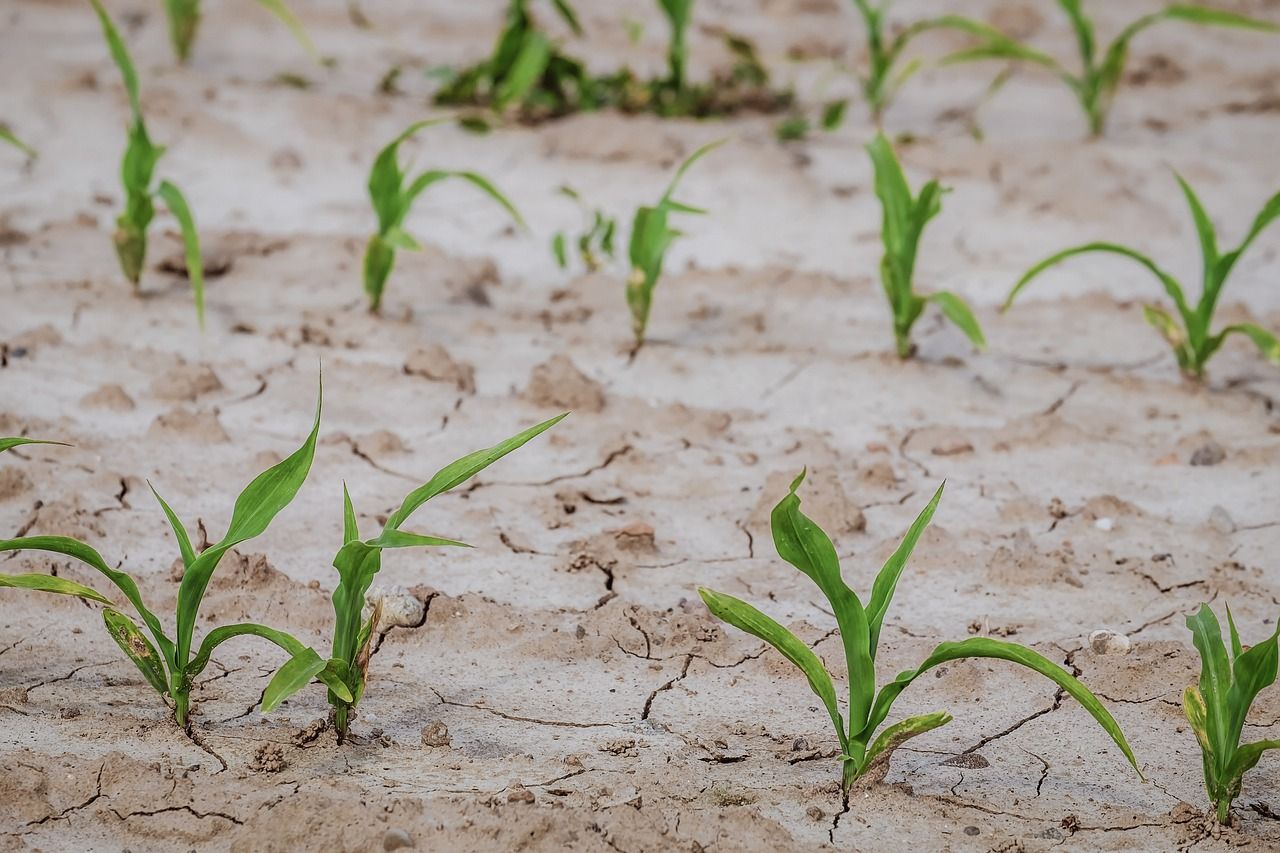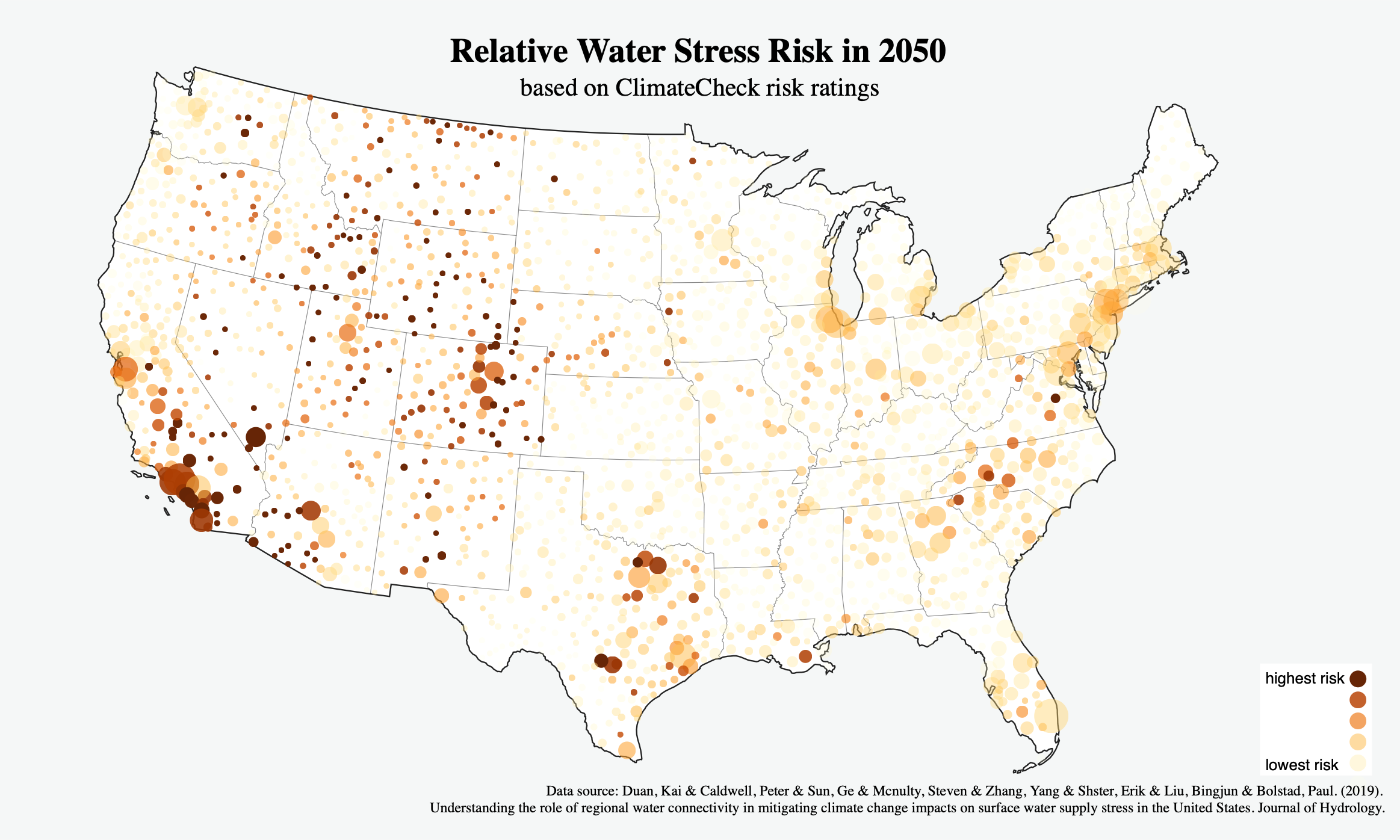What is Drought?
A drought is a period of low precipitation conditions that results in water-related problems. Low precipitation is based on significant decreases in typical rain and snowfall patterns for a region. Droughts are not as violent as other weather phenomena like derechos, hurricanes, or tornadoes but they can be incredibly harmful. They can cause crops to fail, harm wildlife, reduce the amount of water available for drinking, and lead to severe economic problems.

What Causes a Drought?
Droughts can be caused by natural factors, or can be a result of climate change and other human-related influences. Regions differ in the typical yearly amount of rain and snowfall, but droughts can occur even in areas with high precipitation.
Drought is fundamentally connected to the operation of the water cycle and weather systems. Natural inconsistencies in weather systems can lead to areas of abnormally high and low precipitation. Changes in wind and weather patterns can cause long-term variations in the normal amount of rainfall. Human-induced changes to river systems or over-consumption of water resources can also cause systemic drought symptoms to areas downstream or within the same drainage system.
Fluctuating ocean and land temperatures are a major influence on drought. Hotter land surface temperatures lead to increased evaporation of moisture from the ground. This can have a direct impact on the severity and length of a drought. Temperature extremes also impact weather events such as La Niña, which can lead to severe droughts in the southwestern United States.
Types of Drought
There are four primary types of droughts:
- meteorological: lack of precipitation
- agricultural: lack of moisture in the soil
- hydrological: low levels of water in lakes and reservoirs
- socioeconomic: shortages of running and drinking water
The first three characteristics describe methods of tracking the severity of drought conditions, the last describes how economic and social conditions can affect the ways that water is used and consumed.
How is Climate Change Increasing Drought Risk in the US?
Rising temperatures, changes in precipitation, the depletion of water resources caused by climate change are intensifying drought risk. Droughts are very likely to be stronger and longer lasting than in the past.

Human caused disruptions to our natural ecosystems put a strain on the health of our water systems. Drastic changes to the environment such as the release of greenhouse gases, deforestation and increased consumption of water resources are all major contributing factors. Plants and trees form an important part of the water cycle by redistributing water and releasing moisture into the atmosphere. Tree cover decreases evaporation from rivers and soil and lowers the temperature of the surrounding area by offering shade. Human consumption and use of water reservoirs for drinking, irrigation, and recreational activities adds an additional strain on water resources. These consumption patterns have been estimated to have increased the frequency of droughts by 25 percent between 1960 to 2010.
Hotter temperatures caused by climate change lead to greater evaporation of water from the soil. Drier soil can lead to diminished plant cover which can impact the water cycle and reduce rainfall. Warmer conditions are causing changes to the function of atmospheric rivers, narrow regions of the atmosphere responsible for the transportation of water vapor. These changes have the potential to make droughts significantly worse in the future.
Climate change has resulted in a decrease in snowpack across the U.S., especially in the Western states. These changes have resulted in more rain precipitation instead of snow and shifts in snowmelt patterns. This can result in the increased frequency, intensity, and duration of droughts. In 2012, roughly 81 percent of the continental U.S. experienced abnormally dry conditions.
Which Areas are Affected the Most By Drought?
In the United States, the Southwest, the Midwest, and the Southeast are the areas that are most affected by droughts.
Some of the states that are the most affected by droughts include:
Cities that have high drought risk include:
- Las Vegas, NV
- Palmdale, CA
- San Clemente, CA
- San Diego, CA
- San Antonio, TX
- Yuma, AZ
- Temecula, CA
- Colorado Springs, CO
- Los Angeles, CA
- Denver, CO
People who live in these states are significantly more likely to experience droughts and the negative effects that are commonly associated with them. The Southwest receives the least rainfall in the U.S. and the South generally experiences the warmest temperatures. Both of these atmospheric conditions are contributing factors to the severity in these regions.
Recent Droughts in the U.S.
When severe droughts occur, they can create significant amounts of damage and destroy vast quantities of crops. For example, in 1988 the Pacific La Nina Drought heavily impacted the central United States. During this drought, approximately 50 percent of the crops in the Great Plains were completely destroyed, having a devastating impact on the economy.
Throughout American history, there have been many other severe and destructive droughts. For example, here is a list of some of the worst droughts in U.S. history:
- The Civil War Drought – 1850s-1860s
- The 7-Year California Drought – 1928-1934
- The Dust Bowl – 1931-1941
- The 1961-1969 New England Drought
- The 2011-2019 California Drought
- The 2016 Southeast Drought
What are the effects of Drought?
Every year in the United States, droughts directly and indirectly cause an average of $9 billion worth of damage. This damage comes largely from crops and livestock being destroyed as well as a loss of economic activity and reduced income in drought-affected areas. Where droughts occur, they can lead to social unrest, forced population migrations, and sometimes even starvation and dehydration that can lead to death.

Droughts can cause significant and expensive property damage. Droughts do not level buildings like hurricanes and tornadoes but they can reduce the stability of the soil leading to shifting structures and damage to foundations. Behind hurricanes, they are the second-most costly weather events in America. Unlike hurricanes, drought conditions can continue for months or even years, causing long term damage issues.
Drought Risk Adaptation Options for Homeowners
If you live in a high drought area of the United States, you or your property are likely to be impacted by a drought at some point. Mitigation options are a powerful tool to reduce the risk of extreme drought harm to your property. The most common and damaging form of property risk due to drought and drying soil conditions is damage to foundations. Dry soil shrinks, causing gaps beneath your foundation which can lead to cracking and other issues.
Droughts may be a serious problem, but they cause damage more slowly than other types of weather problems. Because of this, as long as you stay vigilant, you can reduce the chances of severe damage occurring to your property.
Understand your local environment and water systems.
- If your area is experiencing drought, research the impacts that it is having in your community
- Know which groundwater or surface water source your water comes from
Check your home infrastructure.
- Routinely check for foundation damage and cracks and repair accordingly
- Check for water leaks or inefficient uses of water by your home devices
Take steps to create a drought resistant environment surrounding your home.
- Spray water around your foundation to prevent soil dryness and settling issues
- Plant trees, shrubs or other plants to increase shade cover and decrease moisture evaporation
- Use native plants in landscaping that require less water usage and are better at using the water that is available, a process known as xeriscaping
- Use mulch to help retain soil moisture
Be aware of your risk level and purchase appropriate homeowners insurance
- Check with your insurance agent to check that you have the best coverage to protect yourself from drought symptoms
- Be aware that slow, structural foundation damage due to changing soil conditions is often not covered by standard policies, you could be at risk of significant financial damage
Conclusion
Droughts are one of the longest-lasting weather events and their longevity makes them dangerous and destructive. Living in an area which is drought-stricken presents many challenges. Following the appropriate water use guidelines for your area and being aware of local water issues is an important part of protecting your community from drought damage.
With the ClimateCheck property report, you can gain tools to assess your risk and mitigation options.
Read More About Drought Risks and Climate Change